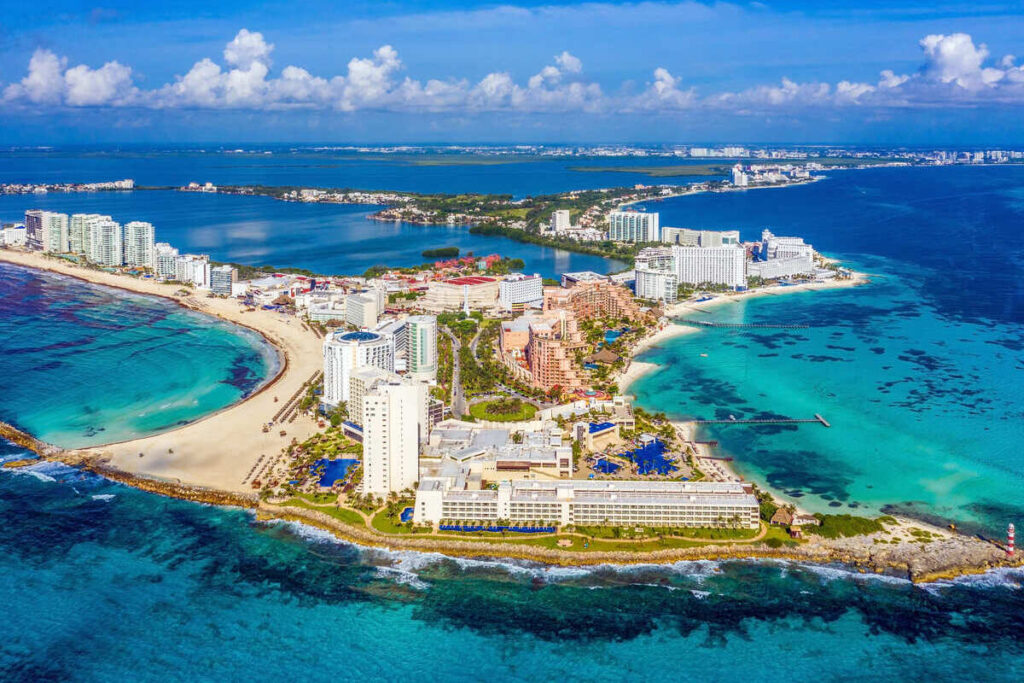No products in the cart.
Travel Guide
Book Your Trip To Cancun Before March To Avoid This Major Problem
Last Updated
If you’re on the fence about booking that trip to Cancun now as opposed to later, in the low season, you may want to think about booking now. Whether it’s high prices holding you back or limited offers, we should remind you now is the best time to travel if you want to avoid a major problem. Beginning in March, sargassum seaweed will begin washing ashore again, and this time, the volume could be overwhelming.

Every year, the microorganism infamously batters the Caribbean coast, tarnishing the pristine nature of its white sand crescents and ruining the Mexican beach experience. Stepping over the smelly deposits as they make their way to a not-so-blue sea, painted a darker shade by the brown algae, is every traveler’s worst nightmare.
Based on the latest data, those heading to Cancun in the near future might want to bring their flights forward by a few weeks to be on the safe side:
Sargassum Season Will Be Worse This Year

After battling the phenomenon for most of 2022, Cancun – and the wider Riviera Maya – is currently enjoying a sargassum-free winter. As local specialists have affirmed, winter is the perfect time to visit the region due to the strong winds blowing from the north that help keep the seaweed at bay, in spite of the warm temperatures known to boost its spread.
Regrettably, the winds are fast-changing, and sargassum levels are bound to increase dramatically come spring. According to the newest report issued by Zofemat – an acronym for Zona Federal Maritimo Terrestre – 2023 will see a collection of algae equal to, or even higher than last year’s, with every major destination on the Riviera Maya likely to feel the impact.
Top 5 Travel Insurance Plans For 2023 Starting At $10 Per Week

This is particularly worrying, seeing that, throughout 2022, around 37,000 tons had made landfall. As stated by Lourdes Várguez Ocampo, director of Zofemaet, the numbers up to December 31 were already exceedingly high, and expecting further occurrences, preparations for the upcoming ‘intense’ sargassum season are underway at this stage.
What Can Travelers Expect Flying To Cancun After March?

In early 2022, the situation was so critical a popular beach in Playa del Carmen, a small resort town south of Cancun, was closed while cleaning was carried out. Beaches were still not completely shielded, and cleaners were routinely seen working round the clock to remove the excess seaweed. This year, they’re better equipped:
The Government has invested heavily in new machinery to divert it, but despite their best efforts, Carmen is again battling a seaweed surge as early as January. Luckily, the sargassum arriving right now is reddish and lighter in nature, ‘easier to harvest’. From March, however, tourists should expect a return of the brown, foul-smelling version.

Playa del Carmen may be bearing the brunt of it, but neighboring hotspots like Puerto Morelos, Tulum, and of course, Cancun, are also set for record levels in spring. With this in mind, Ocampo notes the Quintana Roo Administration has budgeted 40 million Mexican pesos for a wide range of anti-seaweed measures.
These may include sargassum barriers, ‘sandbonis’, and the so-called ‘sargaboats’, which collect the invasive microorganism before it makes it to land. Authorities are going above and beyond what is required to ensure vacationers do not face any kind of disruption, such as closed beaches, but it’s hard to say this far in advance whether that will be enough.

Quintana Roo Takes Tourism Very Seriously
One thing is clear: Quintana Roo takes tourism very seriously. Besides cordoning off the coast to maintain beaches in their pristine nature, the Government is adding new security forces to tourist spots in Tulum and deploying the National Guard to the soon-to-be-launched Maya Train to protect visitors from crime.

While Mexico can always crack down harder on violence, there’s only so much they can do when it comes to sargassum, especially when sea temperatures keep rising, the main factor behind algae reproduction. Every year it gets worse, and the four-month cycle for sargassum-free sunny breaks in the Mexican Caribbean keeps getting shorter.
In the end, it’s up to you to decide whether traveling now and paying more for perfectly clean beaches and a turquoise-colored ocean is a trade-off you’re willing to go with. Alternatively, you could consider exploring this lesser-known destination in southern Quintana Roo that’s recently earned the nickname of ‘New Tulum’, and where seaweed is definitely not an issue.
Traveler Alert: Don’t Forget Travel Insurance For Your Next Trip!
↓ Join Our Community ↓
The Travel Off Path Community FB group has all the latest reopening news, conversations, and Q&A’s happening daily!

SUBSCRIBE TO OUR LATEST POSTS
Enter your email address to subscribe to Travel Off Path’s latest breaking travel news, straight to your inbox
This article originally appeared on TravelOffPath.com
Source link

